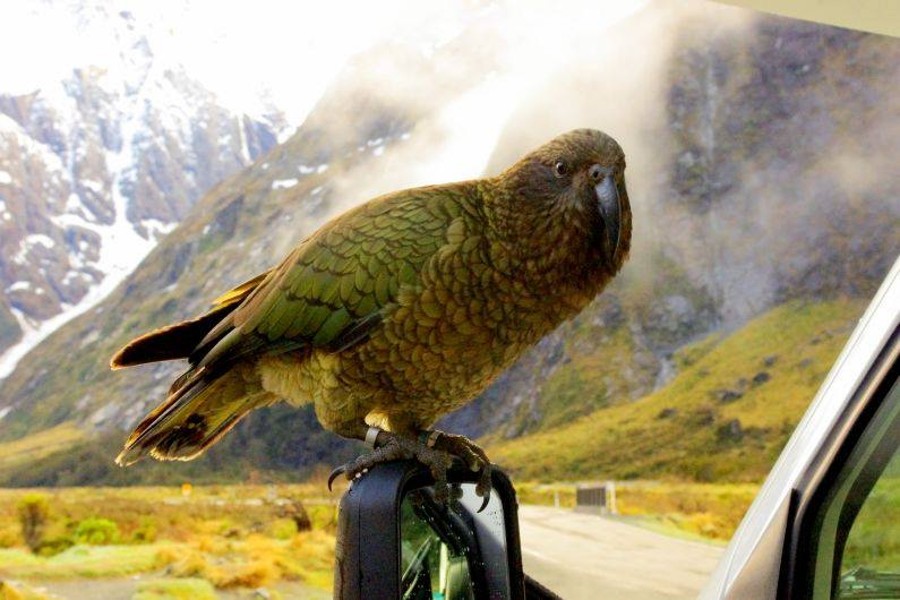EWR comment: the 1080 issue is still as present as ever. It has been overshadowed more urgently at this blog by the CV VX rollout. The 1080 poisoning however continues, business as usual with currently the East Cape to be slathered with this deadly poison. Sixty years on and we still have the pests? How long does one keep applying a solution that doesn’t work? Meanwhile the beautiful Kea is in serious decline. If you are new to the 1080 problem here in NZ just watch the GrafBoys’ excellent award winning doco ‘Poisoning Paradise‘ & visit their site tv-wild.com. Also see our 1080 pages (main menu). Article below…
__________________________________________________________________________
IMPORTANT UNPUBLISHED LETTER BY DR. FIONA McQUEEN – THE WANAKA SUN
“…most conservation –minded NZ’ers would be fairly shocked to hear that 1080 actually kills native birds – in any numbers, small or “huge”. This unfortunate fact has been well and truly proven in peer-reviewed studies and is termed “by-kill”. Which species? Tomtits, robins, morepork and kea to name a few… after the 2020 drop in the pristine Matukituki Valley, 50% of DoC’s monitored kea died”
Dr Fiona McQueen
From Carol Sawyer
On April 15, 2021, The Wanaka Sun published an opinion piece by Ross Sinclair, committee member of the pro-1080 poison Central Otago Lakes “Forest and Bird”…. incorrect and biased as one might expect.
Over the ensuing weeks there were a number of ‘Letters to the Editor’ in opposition to this article. (Notably there were none in support of the opinion piece, although Ross Sinclair was given the right of reply not once, but twice!)
One letter was from Dr. Fiona McQueen, consultant rheumatologist at the SDHB, and author of “The Quiet Forest: The Case Against Aerial 1080”.
The Sun’s editor, Pat Deavoll, told Dr. McQueen in an email on 19 April that she would “certainly publish it in the next edition- you have made some very good points”. It has never been published.
I posted it on Facebook a week ago along with the original opinion piece, with Dr. Fiona McQueen’s permission.
Strangely, I shared it to Upper Clutha Community Notices, a local Wanaka Facebook group with more than 7,000 members. It was approved and then quickly deleted and when I pointed this out to one of the admins with whom I have had cordial dealings in the past, it was reinstated. It was deleted again; again I pointed this out and it was reinstated. It appeared there was disagreement among the admins.
Finally, after 24 hours or so, comments were turned off, this particular administrator sent me an extremely rude private message, totally uncalled for, referring to “your precious post”, the post was deleted, and she blocked me.
Dr. McQueen’s letter STILL has not been published by The Wanaka Sun and yet here in this week’s issue is a letter from John Veysey, commenting on the non-existent letter !! (I thought I must have made a mistake but I have been back through the last 6 weeks of The Wanaka Sun and, no, Dr. Fiona McQueen’s letter has never been published).
Here is her letter again, and I have attached John Veysey’s letter to The Wanaka Sun, from this week’s edition, (which must have a few people scratching their heads as no-one reading The Wanaka Sun has ever seen Dr. McQueen’s letter) :
“Dear Sir,
I would like to make some comments in response to your recent article, “Putting 1080 to Bed”. Firstly, I would expect that most conservation –minded NZ’ers would be fairly shocked to hear that 1080 actually kills native birds – in any numbers, small or “huge”. This unfortunate fact has been well and truly proven in peer-reviewed studies and is termed “by-kill”. Which species? Tomtits, robins, morepork and kea to name a few. How many are killed?
Contrary to Dr Sinclair, I find the data on kea to be extremely alarming. It has been estimated (by DoC) that each poisoning operation will kill, on average, 12% of kea. But sometimes that percentage has been much higher. For example after the 2020 drop in the pristine Matukituki Valley, 50% of DoC’s monitored kea died.
“The keas’ deaths will be horrific, with extreme muscular spasms going on for many hours,” said Dr Jo Pollard, PhD, an independent scientist who has crusaded for years against the use of aerial 1080.
Personal confirmation of this came to me quite separately from an individual working on a DOC hut during 2020. In the days following a 1080 drop he commented, “the keas were making a really awful noise, it sounded like they might have been screaming …” It is very disturbing that there are so few of these iconic birds to be found now around the West Coast, in areas where they used to be plentiful. DOC says its the stoats. Really? Stoats were introduced more than a hundred years ago. The kea population only seems to have plummeted in the last twenty or so (since intensive and repetitive 1080 drops have been underway in kea habitat). More likely it is something that most definitely kills them in large numbers – 1080.
Ross Sinclair has alluded to the recently published paper by Bomans et al, (NZ Journal of Ecology 2021) investigating the effect of 1080 drops on birdsong. True, there was very little difference shown between 1080 and control groups over a period of years (leaving aside the subgroup of tomtits exposed to 1080 where birdsong was reduced). But hold on, shouldn’t there have been a difference? Isn’t that what the whole 1080 programme is supposed to do? Bring back the birdsong? Here is conclusive scientific proof that it is a complete waste of time and money, with a lot of dreadful suffering thrown in for many helpless creatures.
Dr Fiona Mcqueen
Consultant rheumatologist
SDHB”

Related posts:
Views: 0
 RSS Feed
RSS Feed

















 June 7th, 2021
June 7th, 2021  Awake Goy
Awake Goy 
 Posted in
Posted in  Tags:
Tags: 
















